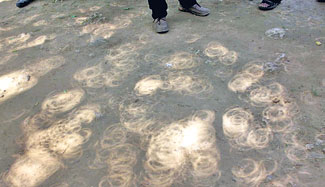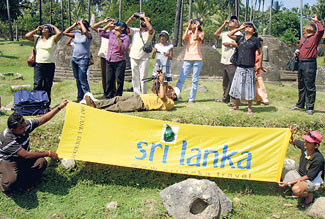Six years after I first flew into Jaffna in May 2003, the civil war had ended and the A9 highway was now finally open with no travel restrictions. The annular eclipse of the Sun on January 15, 2010 being a good reason to return to Jaffna, I decided to join the trip organised by Haka Lanka Tours for the Archaeological Society. Members with family and friends from age three to 80, were all excited about the prospect of seeing the eclipse and Jaffna, most for the first time.
We met at the Colombo Museum on the 12th evening and left at about 10 p.m. in a large tourist coach. Although travel via Puttalam is 10 km shorter, the 74 km from Puttalam to Anuradhapura was very slow and bumpy due to road construction. After an early breakfast near Anuradhapura we travelled via Vavuniya, and crossed over at Omanthai to former-LTTE held territory. We had obtained permission letters from the Ministry of Defence, but they were hardly needed. Throughout the journey, checks were just a quick formality, no different to those encountered in Colombo.
The former war zone was hardly populated except by the Army. Most buildings were in ruins and had no roofs. Reconstruction had still to start. Landmine signs still indicated land cordoned off even close to the A9. We saw some demining activity using an automated crawler type deminer gifted by the UNHCR. Stopping briefly at Killinochchi, some of us sent off postcards from the Post Office which was one of the few government institutions to function through the years the territory was under the LTTE. The large water tank that was toppled by the retreating LTTE portrayed the devastation.
With various stops along the way, we reached Jaffna late afternoon. Most of the group was staying at the Guest House of the Naga Vihara. Since that was overcrowded and in poor condition, being still mostly occupied by the Forces stationed in Jaffna, a few of us stayed in the Cozy Rest which was round the corner. It was the hotel with the most number of rooms and its restaurant has become a hub for foreigners and expats who can afford the inflated prices, due to the lack of significant competition.
After settling in we did not have time to see the places we hoped to visit that day. The Nallur Kovil being prepared for the Thai Pongal festival the next day had closed early, but we visited the locally famous Rio Ice Cream parlour and marvelled that we were able to walk around freely late at night.
The next day we left early to get to the ferry to visit Nagadeepa. The ferry that was just leaving was too full to accommodate our group of 42, and we needed to wait for the next, for the short 3 km ride. They were finding it difficult to cope with the sudden influx of tourists. The ferries are old and not very pleasant inside.
The whole of the Jaffna peninsula was known as Nagadeepa, the island of the Naga people. The famous Nagadeepa vihara on the Nainativu island is a site which is believed to have been visited by the Buddha. Hardly anything of the ancient site remains in the temple of worship. Off the beaten track, however, within walking distance is a small site called Buddha walauwa with an ancient statue of the Buddha.
The largest island Neduntivu is better known by its Dutch name - Delft. We hired a ferry for the group, and the journey of over one hour was pleasant. I was able to sit with my friend right in front on top and get away as far as possible from the loud engine. When we arrived we were told to get back to the boat before 3 p.m. because the sea would be choppy after 4 p.m.
The Delft island is home to a few thousand people. Transport is limited to a single bus and a few trishaws. The only other vehicle which could take us around was a tractor with trailer. We piled into the trailer for a rollercoaster-like ride as the driver tried to show us the sights in the limited amount of time. Wild ponies are symbolic of Delft and we saw a few of them.
We first visited an ancient site with the base of two stupas which have not yet been properly documented or excavated and then the ruins of the small Portuguese Fort behind the hospital. It had thick walls made of broken coral, like most of the fences on the island. The next stop was the Baobab tree, which is the longest living species of trees and native to Ethiopia.
Back in Jaffna the next day we left early to see some sites before the eclipse started. The avaddapuram kovil had an old Vel cart with intricate carving. The Naguleswaram Shiva Kovil, and the nearby baths of Keerimalai hot springs were next on our itinerary. We then travelled to Jambukola where Sanghamitta Theri landed with the Bo-sapling. The ancient site has been destroyed but been tastefully reconstructed recently.
We decided to observe the eclipse from Kathurugoda (Kantharodai) which is a unique 3rd century BCE Buddhist site with over thirty small stupas a few metres in height and diameter.
I had purchased a large number of 2x4 inch shade 13 welding glasses so that everyone could view the eclipse safely. On our way we passed a school where we saw children looking at the Sun without protection. The safety message had obviously not got through. We stopped and gave them the welders’ glasses.
We got to Kathurugoda soon after the eclipse had started at 11:17 a.m. and set up to observe it from this picturesque site. Since the Sun is not fully covered it does not become dark, but we did notice that it became significantly cooler, while staying out in the midday heat.
 |
| Rings on the ground formed by the eclipse (abve) and (below) enthusiasts observing the eclipse from Kantharodai, a unique 3rd century BCE Buddhist site |
 |
The sky was perfectly clear with no clouds. We had selected an ideal spot to observe the eclipse. I locked the focus of my digital camera to infinity and switched off Auto-focus, and set shutter speed to 2 milliseconds (1/500). I taped a 2-inch diameter shade 13 welders glass disk I had got cut out in front of the lens. My 12x50 binoculars also had 2 such disks pasted in front of objectives. By lying on the ground and holding the camera, I was able to get a nice series of 150 photographs, mostly of the annular eclipse from 1:20 to 1:30 p.m.
During the partial phase I looked for a tree under which I could see the multiple images of the crescent Sun made by the random pinholes made by the leaves as they fluttered in the wind. The 10 minute annular phase was long enough to go and see the rings under the same tree.
After the eclipse we returned to Jaffna and visited a few more sites, the Nallur Kovil, the Sangili Topu, the Mandri Manai and the Jaffna Fort.
It was a wonderful five-day trip to Jaffna.There will be no more solar eclipses, even partially visible from Lanka till the next annular eclipse of the Sun on December 26, 2019, visible only from Jaffna.
Jaffna then will probably be a lot different from what it is today.
For more information please visit: http://lakdiva.org/eclipse2010/
(The writer is an Astrophysicist and chairman of the IYA2009 Committee for Sri Lanka) |
